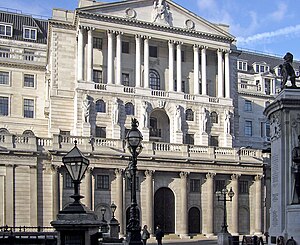| The Bank of England in Threadneedle Street, London. Deutsch: Sitz der Bank von England in der Londoner Threadneedle Street. (Photo credit: Wikipedia) |
Typical Monetary Policy
A central bank’s primary and most effective tool when influencing or controlling the speed at which the economy is growing is the base interest rate. In the UK the central bank, the Bank of England (BoE), defines this rate as the rate at which they will lend to other banks. In short, by lowering this base rate, other banks are able to borrow at a lower rate and consequently offer lower interest rates in turn on both loans and savings accounts to their customers. These customers therefore have access to more affordable (due to the lower loan repayments) money with which to grow their businesses or to spend on goods and services. Meanwhile, the lower interest rates on savings accounts reduce these potential returns and so there are less incentives for customers to deposit their money as savings. All these factors make investment opportunities more attractive and spending more likely; thus increasing the flow of money through the economy.
When Quantitative Easing Is Used
This system works well as long as the base rate has room to be lowered. However, when it is too low to be reduced any further the central bank must look to other solutions to encourage further spending and investment. What’s more, when a base rate is lowered in response to a lack of liquidity and growth in the economy, there is a point at which banks can become more reluctant to lend. This is caused by the twin effects of lower yields for the bank on their loans, due to the tendency for the interest rates across the market to be lower, and the increased uncertainty surrounding whether individuals and businesses will be able to make their repayments. All of which reduces the money reaching invdividual’s and businesses and subsequently their spend and investment on goods and services within the economy, slowing down growth.
When the central bank encounters a situation such as this, as has been the case in a number of economies in the last few years, they can utilise a secondary tactic of quantitative easing. The basic principle behind quantitative easing is to introduce more money (i.e., more liquidity) into the economy to spur spending and growth, by using newly created money (colloquially referred to as ‘newly printed’ although in truth it is all done electronically). This new money is injected by the central bank when they purchase government bonds (i.e., government debt) from private companies, as explained further in the second installment of this article, with the aim of there being a trickle down effect throughout economic markets to other businesses and individuals.
Managing Growth
The level of spending in the economy can be intimated by the inflation rate - the percentage rate at which the value of goods and services are changing, usually increasing, in price. A high inflation rate reflects the fact that there is high demand for these goods and services within the economy, although the higher it becomes, the greater the chances of a rebound effect that then reduces demand and slows spending - high inflation means high prices and these prices can reduce the affordability of goods and/or money will start to lose its value (particularly in the case of hyperinflation such as was seen in Germany in the inter-war period). Therefore, countries tend to aim towards a stable rate of inflation which reflects growth with a sustainable momentum.
In the UK, a committee within the Bank of England called the Monetary Policy Committee (MPC) has the remit of attempting to maintain a stable rate of inflation at 2%. To that end the committee is responsible for a number of monetary policies. including setting the base interest rate and overseeing the BoE’s quantitative easing policy.
The second installment of this article looks at how quantitative works and achieves this aim.
To find out more about investing in global economies you can visit Stocks and Shares ISA Plan.


No comments:
Post a Comment